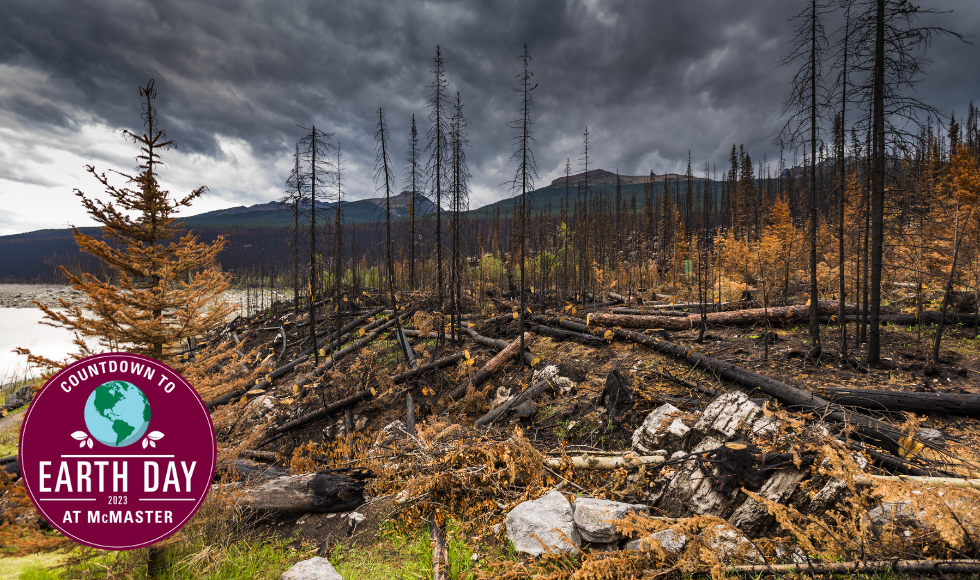Filter that effectively clears ash, dissolvable debris from water after wildfires identified

Wildfires burn an average of 2.5 million hectares of Canadian forests every year, according to Natural Resources Canada. After a fire, ash and other organic materials end up in source water, threatening the drinking water of nearby communities.
BY Matt Innes-Leroux
April 20, 2023
Organic filters composed of sand coated with a living layer of microbiological material can effectively remove ash and other dissolved organic matter from drinking water after wildfires, according to new research from McMaster University and the University of Waterloo.
The simple technology could help remote and marginalized communities recover faster and more affordably after major fires, with the sand filtering particles and the microbiological layer breaking down dissolved organic material.
Wildfires burn an average of 2.5 million hectares of Canadian forests every year, according to Natural Resources Canada. After a fire, ash and other organic materials end up in source water, threatening the drinking water of nearby communities.
Researchers gathered water from the Grand River near Kitchener, Ontario and added ash from a 2020 fire in British Columbia. They ran the ash-amended water through a series of filters containing quartz sand, using a laboratory-scale process similar to what larger municipalities typically employ in water-treatment facilities.
The researchers were able to confirm the process was effective both in improving the turbidity, or clarity, of the water and the concentration of dissolved organic carbon concentration. The findings appear in the journal ACS ES&T Water.
“The biofilters were able to remove the wildfire ash-associated dissolved organic matter down to a range that would be acceptable for a finished drinking water,” says Sarah Dickson-Anderson, co-author of the study and a professor of civil engineering at McMaster.
“The results suggest that if you were to use this type of biofilter in a remote or marginalized setting and you have a wildfire, the treatment may not be disrupted and could potentially provide drinking water,” says Dickson-Anderson.
“Of course, these experiments were conducted at a small scale, so more work needs to be done to confirm, and scale up these results.”
Conventional water filtration focuses on particle and pathogen removal, requiring chemical coagulants even when the quality of source water is high. While ash and other organic matter are not necessarily contaminants, ash contributes to the dissolved organic matter and can be challenging to treat. It is a precursor to the formation of potentially harmful compounds when mixed with chlorine, which is typically required to disinfect water. Removing dissolved organic matter requires using coagulating chemicals and the costs can be staggering.
Since a 2016 wildfire destroyed more than 3,000 buildings in Fort McMurray, Alberta, the cost of providing safe drinking water have exceeded $60 million. This is a result of the elevated levels of natural organic matter in the water from the ash.
“Running water through a biofilter is a lot easier than conventional treatment, which involves adding coagulants, mixing, filtration, and settling. There are more pumps and more machinery involved in that, and a much larger burden on drinking water treatment plant operators. Biofiltration is a more passive treatment approach and we’re trying to see if it would be a resilient solution for low resource settings, particularly when the source water quality is disturbed, for example due to a wildfire,” says Dickson-Anderson.
Beyond wildfire recovery, the passive nature of biofilters could benefit smaller communities that are unable to fully staff municipal water treatment facilities with qualified operators because of limited resources.
“Many small, rural, and Indigenous communities in Canada are facing a big challenge to attract and retain enough qualified drinking water treatment plant operators to keep their plants running 24 hours a day, 365 days a year,” says Dickson-Anderson. “Just because a community has a state-of-the-art drinking water treatment plant doesn’t mean that it can provide safe water to the community – it needs qualified operators to run it well.”
“Biofilters could potentially reduce the operational burden associated with drinking water treatment to alleviate some of the challenges faced by rural, remote, and marginalized communities, without compromising their drinking water quality.”


